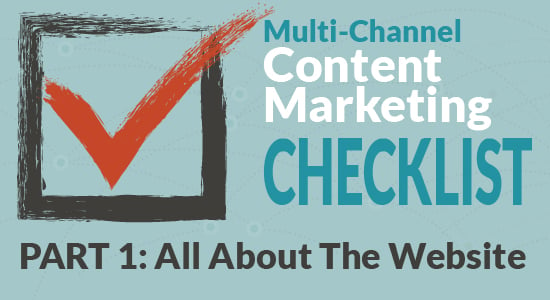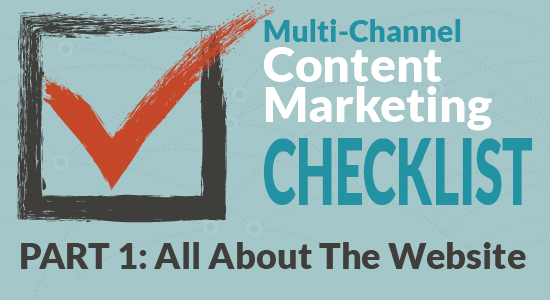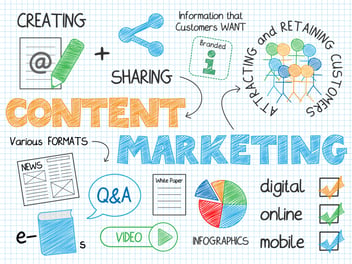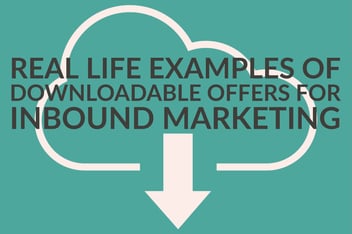Your Multi-Channel Content Marketing Checklist (Part 1: All About The Website)

How many different kinds of content marketing materials did you include in your last B2B marketing campaign? Which channels did you use to reach your target audience?
B2B content marketing is not a one-size-fits-all endeavor—the configurations and combinations of channels, content types and distribution strategies are nearly infinite. But we often get stuck in a rut of doing the same thing over and over. Maybe it’s a whitepaper-blog-LinkedIn routine that feels familiar. But what might you be missing?
While you aren’t likely to create every type of content and use every possible channel listed this post and the one to follow, this checklist can help you and your team brainstorm new ways of repurposing basic content concepts and creating a cohesive library of content that shares the same messaging and brand positioning.
I’ve grouped pieces of content below by the primary channel used to distribute them. There may be some overlap and often one channel can be used to promote content that has been published on another (such as linking from a social media update to a blog post on your company website).
Think of this as your master list of possibilities, and then choose the specific content pieces and distribution channels that fit your available resources—both budget and time. (In this list, I am addressing strictly owned, earned and shared content—not paid advertising, in traditional, digital or social platforms—we’ll cover that another day.)
What new content type or distribution channel will you incorporate into your next content marketing campaign? Here are 14 to choose from to be used on your website—then we’ll cover social media, email, publications and more in Part 2.
Content for your company website
The most basic and universal channel to use to distribute your content is your own website. Your company has complete control and access, plus additional content boosts search results and web traffic, and has the potential, when used correctly, to generate leads and sales there on your website. Chances are good you are already using some of these content types, but consider how you can expand your reach to new audiences or meet additional needs for your leads and customers.
Blog posts:
Business blog posts can take on many forms, from sharing company news to providing detailed how-to articles that your readers can use to solve problems or analyzing industry data and projections. Marketers that prioritize blogging see 13 times the ROI of businesses that don’t. (HubSpot)
Product descriptions or features:
Depending on your industry, this could range from detailed specs to more broad benefits offered by a service your company provides. Either way, online information growing in importance in the B2B world, with 74 percent of B2B buyers reporting that they research at least half of their work purchases online. (Big Commerce, Forrester)
Explainer or introductory videos:
Video content featured on the corporate website, whether as an introductory visual on the homepage or explainer videos on product pages, can be a key part of setting the tone and establishing brand messaging for website visitors. That trope that a picture is worth a thousand words? It may apply to video as well, as 72 percent of customers would rather learn about a product or service by way of video. (HubSpot)
Resource library:
Provide your website visitors with resources that help them solve their problems, and you will become a trusted source of information. That trust can translate into sales and referrals as well. If you want to use your library to generate online leads, gate offers behind landing pages so you can nurture those new leads with additional content. Ideas for your resource library content:
Ebooks: Ebooks, whitepapers and reports each take a slightly different approach to providing information to your website visitors and prospects. Think of ebooks as the least formal style.
Whitepapers: Whitepapers, sharing expertise backedup with data, illustrations and charts, remain a mainstain in B2B marketing, even if they may have transitioned from printed materials to a digital format. More than 7 in 10 B2B buyers say they have used a whitepaper to research a purchasing decision. (DemandGen)
Reports: Similar to whitepapers, which often focus specifically on a challenge and the solution, reports sharing original research and data build your brand’s position as a thought leader and source of information. According to Mantis Research and Buzzsumo 94 percent of marketers agree that original research elevates a brand’s authority.
Webinars: As with ebooks, whitepapers and reports, webinars provide an opportunity to educate viewers and build trust, and many people prefer a video format to text, with 92 percent of B2B professionals ranking webinars as their favorite content format. Webinars can be presented as live events and/or archived gated material to be accessed at any time. (RingCentral.com)
How-to videos: While webinars may often include interviews and even interaction with the audience in the live version, you can also use how-to videos to provide additional useful visual content for your audience, both prospects and customers. (Find information on many other types of videos you may want to include in your resource library or elsewhere on your website in this exhaustive list from our partners at HubSpot.)
Case studies: Readers love stories, and case studies combine a true story of someone like your reader overcoming challenges with the information about how your reader can do the same—using your solution. More than 45 percent of B2B marketers rank case studies as the most valuable influencer content type. (DemandGen)
Testimonials: While testimonials—concise, specific, solution-focused quotations from your best customers—may not be a true content type by themselves, they can play a key role in various other content pieces you develop, from case studies and videos to product description pages, social media (which we will cover more in the second half of this checklist), and general website content.
Checklists: Not only are checklists a great format to use to bring variety to your business blog as I’ve done here, but they can also be a downloadable resource used to capture lead information. Other types of immediately useable content include templates of all kinds, worksheets and calculators. Check out the “Do” section of our Inbound Marketing Learning Library for a wide range of these types of resources, designed to help our website visitors do their jobs more efficiently.
Podcasts: Podcasts are growing in popularity as a method for marketers to reach audiences and extend the brand message with informative and entertaining content. There are avid fans of business podcasts in 13 million households, and another 52 million households house casual fans of business podcasts. (TopRankBlog) Could yours be their next favorite listen?
Additional website copy:
There are other specific pages on your website that should be written with content marketing in mind, keeping at the front of your purpose who your audience is, what challenges they face and how they make decisions when seeking solutions.
About us: This is your chance to personalize the business and the people in it while reinforcing your brand positioning: what makes your company unique, what are the core values you use in all decision making and who are the individuals that make it all happen.
FAQs: Many potential customers don’t want to actually talk with you or ask questions until they have done a lot of background research themselves. Take time to think about the nuts and bolts questions your leads may ask that can be answered in a quick, concise format. Not only does this help prospects gain confidence that you do have the right solution for them, but it also saves your sales or customer service staff time answering the same questions over and over that could have been quickly found online. FAQs can also be a great way to continue building search authority for your site.
And that list is just for the content you can develop to use on your own website! I may have missed some, too. What other types of content do you use on your own website to support your overall integrated content marketing strategy?
In my next post, I’ll continue the checklist with content ideas you should consider using for distribution through social media, email, third-party publishers and media outlets, print products, and sales enablement or customer service collateral materials. There is some overlap, of course, and you’ll use those channels to promote the content developed for your website. Subscribe to the Inbound Accelerator now so you won’t miss Part 2 and the rest of the checklist.
-1.png?width=1652&height=294&name=Jones(RGB)-1.png)












